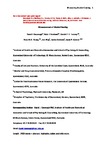Measurement of alcohol craving
Date
2013-02-01Author
Subject
Metadata
Show full item recordAbstract
Despite considerable research activity and application in treatment, the construct of craving remains poorly understood. We propose that cravings and urges are cognitive–emotional events in time, characterised by frequency, duration, intensity and salience. Commonly used measures of alcohol craving are reviewed, and their strengths and weaknesses identified. Most measures confound craving with behaviours, or with separable cognitive phenomena such as expectancies, intentions, or perceived behavioural control. These confounds have limited our advances in understanding the determinants and consequences of craving. Based on the criteria applied in this review, among the better performing multi-item measures are the Penn Alcohol Craving Scale and Obsessive subscale of the Obsessive–Compulsive Drinking Scale. Optimal assessment strategies are likely to involve daily assessments of peak intensity of cravings, desires or urges and of the frequency and duration of craving episodes. Of particular interest are measures of intensity at times when individuals are at risk of drinking or of other functional impacts from craving.
Collections
Publisher
Place of Publication
Journal
Volume
Issue
Pagination
Author URL
Recommended, similar items
The following license files are associated with this item:


